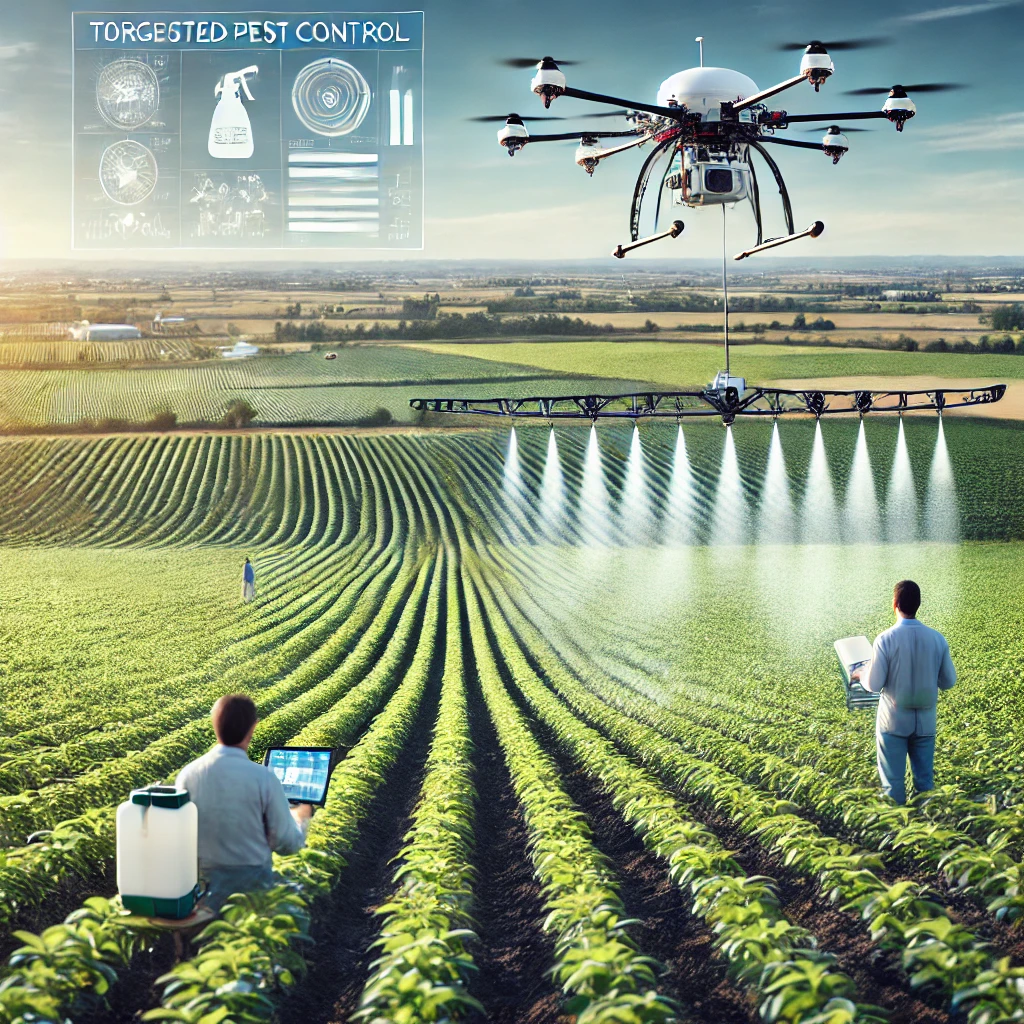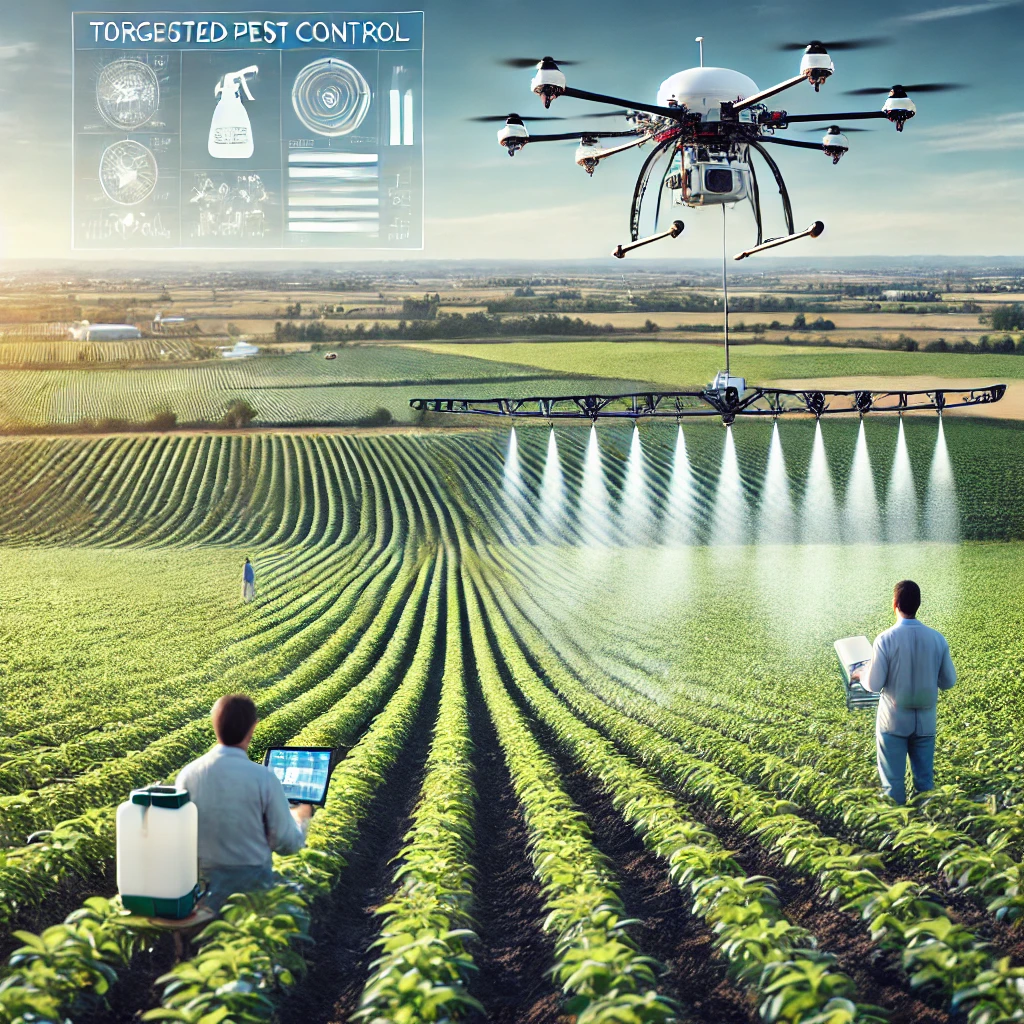
Introduction
Drones, also known as unmanned aerial vehicles (UAVs), are becoming an essential tool in modern agriculture, particularly for pest control on large-scale farms. By leveraging drones, farmers can apply pest control measures more precisely and efficiently, reducing costs and environmental impact. This essay explores the benefits, applications, challenges, and future directions of using drones for targeted pest control in agriculture.
Benefits of Using Drones for Pest Control
- Precision Application: Drones allow for the precise application of pesticides and other pest control treatments, targeting only the affected areas. This precision reduces the overall volume of chemicals used, minimizing the impact on non-target species and the environment. Drones equipped with advanced sensors and GPS technology can navigate fields accurately, ensuring that treatments are applied where they are most needed.
- Cost and Time Efficiency: Using drones for pest control is both cost-effective and time-efficient. Drones can cover large areas quickly, reducing the labor and time required compared to traditional methods. This efficiency allows for more frequent monitoring and quicker responses to pest outbreaks, potentially saving crops from significant damage.
- Reduced Human Exposure: Drones help reduce human exposure to pesticides and other chemicals by eliminating the need for manual application. This reduces health risks for farmworkers and allows for safer pest control practices. Additionally, drones can operate in difficult-to-reach or hazardous areas, further enhancing safety on the farm.
- Real-Time Monitoring and Data Collection: Equipped with high-resolution cameras and multispectral sensors, drones can monitor pest populations and assess crop health in real-time. The data collected can provide insights into pest hotspots, crop stress, and the effectiveness of applied treatments. This real-time information allows farmers to make informed decisions and adjust their pest management strategies accordingly.
Applications of Drones in Pest Control
- Spot Treatment of Pest Outbreaks: Drones can be used to apply pesticides directly to areas with high pest activity, reducing the need for blanket spraying. This targeted approach helps conserve resources and minimizes the environmental impact of pest control.
- Release of Biological Control Agents: Drones can release beneficial insects, such as parasitic wasps or predatory beetles, into pest-infested areas. These biological control agents help manage pest populations naturally, reducing reliance on chemical pesticides and supporting integrated pest management (IPM) strategies.
- Disease Detection and Management: Drones equipped with thermal and multispectral imaging sensors can detect early signs of disease and pest damage that may not be visible to the naked eye. By identifying these issues early, farmers can apply targeted treatments to prevent widespread crop loss.
- Monitoring and Mapping: Drones provide detailed maps and visual data that help farmers monitor crop conditions and pest activity over time. This information can be used to develop more effective pest management plans and optimize field operations.
Challenges and Considerations
- Regulatory Compliance: The use of drones in agriculture is subject to regulations that vary by country and region. Farmers must ensure they comply with local aviation laws, obtain necessary permits, and follow guidelines for drone operation.
- Technical Skills and Maintenance: Operating drones requires technical skills and knowledge of both the equipment and the software used for data analysis. Additionally, drones require regular maintenance to ensure they operate effectively and safely, which can add to the cost and complexity of their use.
- Weather and Environmental Conditions: Drones are sensitive to weather conditions such as wind, rain, and fog, which can limit their effectiveness. Planning drone operations around favorable weather conditions is essential for ensuring accurate and safe pest control applications.
- Initial Investment Costs: The initial cost of purchasing drones and related technology can be high, potentially limiting access for some farmers. However, the long-term savings and benefits often outweigh the initial investment, especially for large-scale farms.
Future Directions in Drone-Based Pest Control
The future of drone technology in pest control includes further advancements in automation, AI integration, and data analytics. Automated drones equipped with AI could independently identify and target pests, apply treatments, and continuously monitor crop health. Improvements in battery life, payload capacity, and sensor technology will enhance drone capabilities, making them even more effective tools in sustainable agriculture.
Conclusion
Drones offer a powerful and versatile tool for targeted pest control in large-scale farms. By enabling precision application, reducing costs, enhancing safety, and providing real-time data, drones help farmers manage pests more effectively and sustainably. As technology continues to advance, drones will play an increasingly vital role in integrated pest management strategies, contributing to more efficient and eco-friendly agricultural practices.

